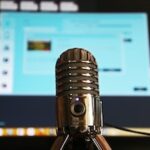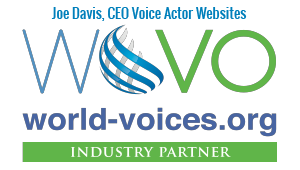No matter what kind of voice actor you are, it’s essential to understand what tools and equipment you need to support your business. It can get overwhelming when you come face-to-face with an exhaustive list of voiceover tools, programs, and equipment, but it is crucial to know which ones you need to produce quality content. The tools you need will vary based on price, ease of use, and benefits. With constantly improving technology, finding the right combination of tech that works for you is crucial. Choosing the right gear and software will depend on what type of work you need to do, but this list of essential voiceover tools will help you get started.
Voiceover Tools – Hardware
When you’re ready, getting your hardware in order is crucial. With solid gear, it will be easier to produce industry-standard sound. For daily work and practice, you need to have a few key things on hand. These include:
Computer: A PC or laptop is essential to send and store audio files you can send to your clients. Paying for cloud storage or using an external hard drive is smart and prevents using up the space on your computer. Some computer fans are noisy, but you can set it up outside your both, so it doesn’t interfere with your recordings.
Microphone: Built-in computer mics do not capture good sound, so a quality mic is also a must-have. If you are serious about voiceover, purchase a condenser microphone with a mixer/interface and XLR connections. The specifics of your mic will depend on other factors like your recording location, mic technique, and how it sounds through your particular recording device.
Studio Headphones: Headphones allow you to hear your voice during a recording and stop your mic from picking up any noise from your speakers. Closed-back headphones are recommended since sound does not bleed out from them, and they also won’t pick up any noise from the mic.
Mic Stand: Keeping the mic steady is essential, too. Depending on your needs, you may choose between a desk stand, a studio arm, or a floor stand.
Shock Mount: These prevent movement or vibrations from the mic, ensuring smoother audio quality. They usually attach to the end of the microphone stand and are sometimes included with them.
Pop Filters: When recording, plosive sounds can make audio levels seem inconsistent. A pop filter is a screen that rests in front of the mic, diffuses any air coming through, and neutralizes the harsh exhales or hisses of any plosives.
Soundproofing: Soundproofing is intended to keep outside sounds out of the studio while keeping inside sounds in. The more mass the boundaries of a room have, the more soundproof it is. Soundproofing tends to be difficult since it is most effective when building a room, but there are ways to increase sound isolation. This can be done by adding mass to an existing room by putting up things like mass-loaded vinyl, Sheetblok, or dense rubber.
Acoustic Treatment: Just like sounds from the outside need to be managed, sounds inside a home studio do, too. Treatment is a vital part of controlling sound inside the studio. It prevents reverb, the sound bouncing off things around you. The walls, furniture, or interior of your studio can throw off the acoustics of your recording by creating echoes. Using bass traps, acoustic paneling, and diffusers helps prevent sound from reverberating.
Voiceover Tools – Audio Editing Software
Options for voice recording software are plentiful, and they each have price points and features to keep in mind. The one you pick should work within your budget and the tools you need, and the ones listed below are an excellent place to start. Products like Garageband are great for starters but will not be included because of key missing features like audio metering, which is required for professional voiceover.
Audacity: This is a great program, especially when starting, because of its ease of use, standard mixing features, Mac and PC compatibility, and accessibility. It has a multitrack editor, live audio recording, import/export settings, plug-in support/creation, mixing, and mastering, and supports 16-bit, 24-bit, and 32-bit.
Sound Forge: Another good program with all the tools you need to create quality audio for $60. It works on Mac and PC and includes multitrack editing, live audio recording, import/export, mixing and mastering, real-time monitoring, and collaboration tools.
Adobe Audition: Audition is a more professional program with various industry standards and standout features, with a $20 per month price point. It is Mac and PC compatible and includes multitrack editing, live recording, import/export settings, editing previews, frequency splitting, auto speech alignment, custom port channelization, third-party controls integration, audio mixing and mastering, and metadata support.
Reaper: Reaper is another great option for those who want a slate of features and reasonable control over their audio files, with a discounted license cost of $60 or a commercial license cost of $225. It is Mac and PC compatible. It comes with API, multitrack editing, live recording, import/export, plug-in integration, third-party integration, audio mixing and mastering, and a graphical workflow editor.
Twisted Wave: This program is enjoyable to use since it is mainly designed for Mac and has a windows version in beta. It costs $99 and comes with live audio recording, mixing and mastering batch file processing, pitch shifting, metadata support, plug-in support, import/export settings, and is a multi-channel (though not a multitrack) editor.
Logic Pro: Logic Pro is an Apple-exclusive editor that costs $200. While on the higher end of the price range, it has several useful features on top of the usual live recording, import/export, plug-in integration, and multitrack editing. Unique features include mobile support across Apple devices, a workflow manager, a score editor,
Pro Tools: Pro Tools works with Mac and PC and costs $300 for a yearly subscription, $30 a month for a one-year subscription, or a continuous $40 monthly subscription. Its sizeable price point also includes features such as API, live recording, data capture and transfer, import and export settings, plug-in integration, activity dashboard, mixing and mastering, multitrack editing, instrument management, synchronous editing, and collaboration tools.
Cubase: This one is a high-end editor with varying features based on the plan purchased. It is Mac and PC compatible, and there are plans for $100, $330, and $580. The $100 version will be covered here, which covers Cubase Elements. It comes with live audio recording, configurable workflow, file management, project management and workflow, score editor, collaboration tools, import and export settings, instrument management, multimedia support, plug-in integration, and project management. The more expensive plans come with more robust versions of the base features.
If you have recommendations for other great voiceover tools, pleas share!



